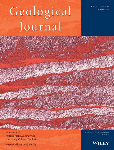“Brackish-water carbonates are far less studied than their marine or limnic counterparts.However, their association with few, specialized species enables the documentation offine-scale changes in the depositional environment. The Cenozoic Mainz Basin(Germany) was only sporadically connected to the North Sea and the Paratethys, expos-ing several transitions from marine to fresh water influence. Focusing on one outcrop ofthe Rüssingen Formation of Mainz-Weisenau (Aquitanian, Miocene), we present adetailed analysis of the faunal and sedimentological responses to changing salinities andwater depth, including algal reef growth and facies development. The deposits includeallochthonous limestones surrounding an autochthonous reef complex and severalsmaller reef patches. The allochthonous facies is dominated by the gastropodHydrobiainflata, and the reef facies is mainly made up by the green algaCladophoritessp. The algalthalli are overgrown by cryptocrystalline, organic precipitations, and laminated, chemicalprecipitations. Locally, quiver-shaped structures of Trichoptera sp. protective casesoccur. The depositional setting was a shallow, low energy, and brackish environmentsupersaturated by carbonate. We could not confirm a general trend of reducing salinitiesas reported for the Rüssingen Formation. Ourresults question previously reported epi-sodic desiccation events, because apparent caliche horizons actually represent thin bedsof increasedCladophoritesgrowth. Set-up, distribution of the reef facies, and reef debrisindicate short-time variations of temperature, salinity and water depth. We concludethat these variations are based on the geographic position at the edge of an algal reefbarrier, separating the Mainz Basin from the Rhine Rift Valley.”
>>> learn more

